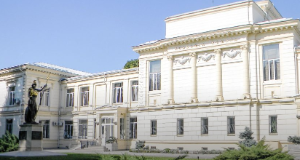News & Events
XII International Congress of South-East European Studies, Bucharest

During 2–6 September 2019, I took part in the XIIth International Congress of South-East European Studies, organized by the Institute for South-East European Studies of the Romanian Academy in Bucharest, where I presented a paper on “Spiritual and Imperial Authority in the Hagiographical Works of Philotheos Kokkinos,” as part of a workshop on The Religious Rhetoric of Power in Byzantium and South-Eastern Europe.
Abstract
Philotheos Kokkinos’ lives of contemporary saints (dedicated to Nikodemos the Younger, Sabas (Tziskos) the Younger, Germanos Maroules, Isidore Boucheir, and Gregory Palamas) sought to shape and were shaped by the political and theological disputes of fourteenth-century Byzantium, especially those surrounding hesychasm. In Kokkinos’ hands, hagiography turned into a versatile tool for promoting not only his contemporary saintly figures and hesychast theology, but also his own personal, political, and ecclesiastical agenda. At the same time, his lives of contemporary saints offer valuable material for the study of literary and hagiographic depictions of imperial power and the relation between the imperial office and ecclesiastical and spiritual authority. Throughout his vitae, Kokkinos praises imperial figures in customary fashion, even penning almost hagiographic portraits for some of them, while subtly criticizing others, and revealing his personal political inclinations. This paper investigates Kokkinos’ depictions of late-Byzantine imperial figures and the power dynamics conveyed in their interactions with their contemporary holy men, reflecting on possible motivations behind these portrayals. It will focus particularly on Kokkinos’ account of the encounter between Emperor John VI Kantakouzenos (r. 1347–1354) and the renowned holy man Sabas the Younger (ca. 1283–1348) in early February 1347, during which the emperor’s authority fails to overturn the holy man’s stubborn refusal to accept the patriarchal throne of Constantinople. Particularly interesting is Kokkinos’ emphasis on the gesture of holding hands between the emperor and the holy man. As I argue, this account sheds light on Kokkinos’ view on the relationship between basileia and ekklesia in late Byzantium.
Last modified: Wed, 05 Feb 2020 16:08:34 GMT



